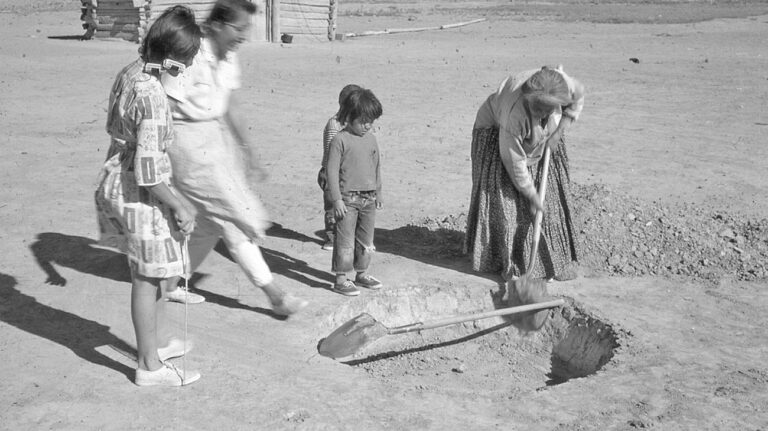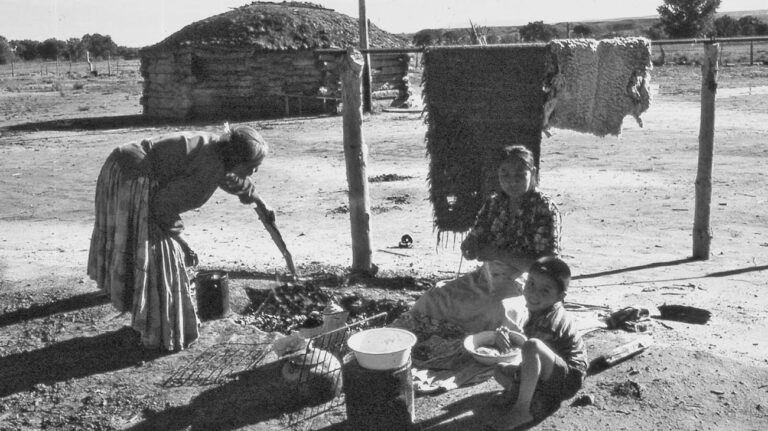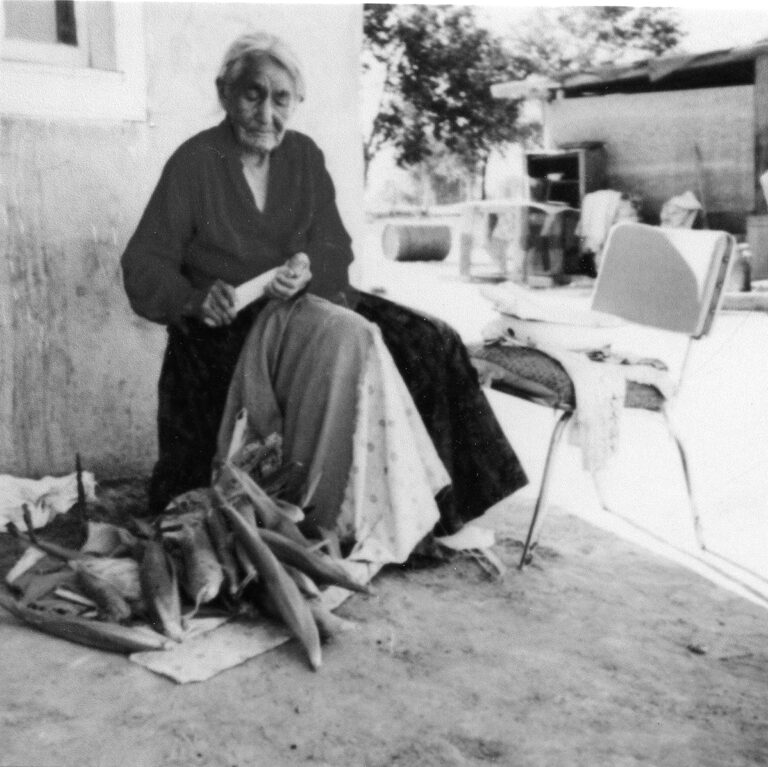I don’t know why I was so nervous going to meet with Dr. Charlotte J. Frisbie. Perhaps it was because of that “Dr.” part—she is a multi-degreed expert in traditional Navajo foodways, and I am, well a student of life, shall we say. She could only meet up over the weekend, as she was driving into town from Chinle, Ariz., for a book signing event at Bookworks on Sunday. When I met her, my nerves quickly vanished—she is all grins, a small woman with sandy hair and a bottomless passion for anthropology and food sovereignty. Frisbie is on tour with her book Food Sovereignty the Navajo Way: Cooking with Tall Woman, which was published this April by UNM Press. She never toured with any of her earlier books, so it’s kind of a novel experience for her. Lest anyone think being a published author is a glamorous affair, she assures me that it’s largely been a process of “driving around with hundreds of books in the back of my car.” No hotel stays for her, either: She’s stayed with friends on every night of this trip.Frisbie is used to moving from place to place, though. Although she lives in Illinois with her husband most of the year (she is a professor of anthropology at Southern Illinois University Edwardsville), since 1963 she has spent much of her time living and doing research in Chinle, a small settlement in the Navajo Nation in northeastern Arizona. It was there that she met Rose and Frank Mitchell and their family, whom she would come to know closely for many years.Frisbie first came to Chinle on a grant to study the Navajo Blessingway ceremony and, more specifically, the singers who perform the holy chants or songs involved in the ceremony. Her advisor at the time connected her with Frank Mitchell, a revered Blessingway singer, tribe councilman and judge, with whom she would publish her first book, Navajo Blessingway Singer: The Autobiography of Frank Mitchell, 1881-1967. During and after Frank’s last year’s of life, she also spent much time working beside his wife Rose Mitchell, whose Navajo name translates to “Tall Woman.”The Mitchells lived a very traditional Navajo lifestyle—meaning they grew, gathered or hunted most of their own food, and they performed the traditional Navajo ceremonies like the kinaaldá (girl’s puberty ceremony) and the Blessingway ceremony. Tall Woman still harvested and prepared traditional Navajo foods such as sumac berries cooked with clay and ntsidigo’í, or kneel-down bread, even as those around her began eating a more Anglo American diet (read: lots of sugar and processed foods). They didn’t have electricity, and Tall Woman cooked and preserved her family’s food without refrigeration or a gas stove. She was a strong, resilient woman with decades’ worth of hard-won wisdom. As Frisbie says in the introduction of her book, “Tall Woman was born six years after many Navajos returned from incarceration at Fort Sumner in New Mexico, and her life included government ration programs; mandated education; the arrival of the railroad, trading posts, missionaries, boarding schools and the automobile; a shift from a subsistence economy to a wage-labor economy; World Wars I and II; stock reduction; the Commodity Food Program; and so much more.”Frisbie, who was originally studying ethnomusicology, became interested in the traditional foodways that Tall Woman practiced. From 1963 to 1977 (the year of Tall Woman’s death), Frisbie learned all she could from Tall Woman—asking endless questions, translating and transcribing recipes and advice, taking photos of her cooking process and working alongside her to harvest, butcher, cook and serve food the traditional way. Much of those years spent working together informed Frisbie’s 2001 book Tall Woman: The Life and Story of Rose Mitchell, a Navajo Woman, c. 1874-1977. But Frisbie realized even then that there was a whole other book to be written specifically about food, as it related to the Mitchell family and to the modern Navajo Nation as a whole.In Food Sovereignty the Navajo Way, Frisbie discusses the way that the Navajo diet has changed under colonization, especially in the past century. In the ’20s, the amount of rainfall in the Navajo Nation and throughout the Southwest drastically decreased due, Frisbie says, to climate change and rampant overgrazing. As the climate got drier and hotter, many of the indigenous plants used by the Navajo for food and medicine began to disappear. At the same time, the Navajo Nation switched more completely to a wage-work economy rather than a subsistence-based economy, and knowledge of how and where to gather and prepare those plants has since faded from the communal knowledge.As the Navajo people’s knowledge of traditional agriculture, hunting and gathering practices languished, reliance on supermarket food and the Commodity Food Program (what later evolved into SNAP) increased. This meant that refined wheat flour began to replace the homegrown, hand-ground cornmeal used for centuries in Navajo cooking, sodas and junk food lined the shelves of the grocery stores and people began buying meat that came from factory farms outside the Nation rather than raising livestock themselves. This was about the same time that rates of diabetes, obesity and other diet-related illnesses began to skyrocket in the Navajo Nation. If you’ve guessed that there’s a causal link here, it’s because you’re paying attention.In chapters 2 and 3 of her book, Frisbie offers up dozens of recipes and instructions for living a self-sufficient life the Navajo way, all gleaned from Tall Woman. Here we learn how to identify and prepare many plants used in Navajo cooking like goosefoot, green amaranth and sweetgrass. We learn about the culinary ash (usually made from juniper wood) that Navajo people used in their baked goods, and the light-colored clay that was used to sweeten some foods. We learn how to butcher a sheep, including what the tastiest parts to eat are and how to cook or preserve every last scrap. This part of the book is an excellent resource for anyone looking to know more about ancient ways of eating and how they might be incorporated into modern diets.In chapter 4, Frisbie reflects on current food sovereignty efforts in the Navajo Nation and around the country. She enumerates the big steps that have already been made—like the Healthy Diné Nation Act that passed in 2014, which created a 2 percent tax on minimal-to-no-nutritional value foods like soda and candy, from which all the funds go to creating community wellness projects like wellness centers, vegetable gardens and farmers’ markets. She praises the grassroots organizations and individuals that are making food sovereignty their goal: groups like Native Seeds/SEARCH, which works to preserve and distribute seeds indigenous to the American Southwest; chefs and food activists like Sean Sherman in Minneapolis, who is reclaiming Native American cuisine through his cooking; and the Resilience Garden at the Indian Pueblo Cultural Center here in Albuquerque that practices “traditional Pueblo farming techniques and cultivate[s] endangered Pueblo crops.”I don’t know if Tall Woman ever used the term “food sovereignty” or considered herself a part of a larger movement, but the work she did in preserving traditional foodways—and the work that Dr. Frisbie has done in collecting and publishing that knowledge—is a valuable tool in the efforts to revitalize indigenous food. This wisdom can help future generations plot a course for food sovereignty in a rapidly changing climate and culture.Since food sovereignty efforts have sprung up in the Navajo Nation, Frisbie says she’s seen massive changes in Chinle. The stores there are stocking fewer sodas and sugary drinks and more traditional foods like jerky and blue cornbread. Funds from the Healthy Diné Nation Act have helped create a community garden. Navajo Technical College has started a culinary program that includes education in making traditional Navajo foods. “More and more of the younger generation are starting to garden,” Frisbie says. “It’s very exciting to witness.”
Dr. Frisbie will be signing and speaking about her book, Food Sovereignty the Navajo Way, at Page 1 Books (5850 Eubank Blvd.) this Saturday, Aug. 18 ,at 4pm. Copies of the book will be for sale, as well as some copies of Frisbie’s older works.












